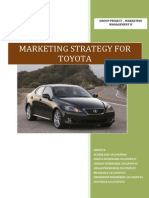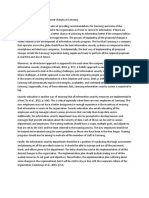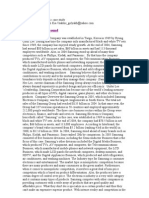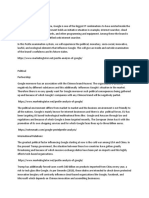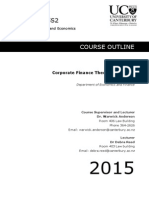Planning Essay For LEGO
Planning Essay For LEGO
Uploaded by
Marilyn WooCopyright:
Available Formats
Planning Essay For LEGO
Planning Essay For LEGO
Uploaded by
Marilyn WooOriginal Description:
Original Title
Copyright
Available Formats
Share this document
Did you find this document useful?
Is this content inappropriate?
Copyright:
Available Formats
Planning Essay For LEGO
Planning Essay For LEGO
Uploaded by
Marilyn WooCopyright:
Available Formats
Planning Essay There is no single optimal planning system.
To be effective, plans must match the conditions a firm faces and be linked to individual and group responsibilities. This essay will discuss certain components of the strategic plan employed by the Lego group over the years, mainly focusing on the fix that wasnt and the managing for cash phases. Some components of planning include strategy, SWOT analysis, strategy feasibility, strategy development, action programs, implementation and control. After the Growth Period that wasnt, LEGO faced their first financial loss in history when their investments to become an unrelated diversified company such as through expanding into videogame software and childrens wear failed to boost sales. Subsequently, COO Poul Plougmann was brought in and there was a change in strategy. While the company still had a differentiation strategy, there was an increased focus on cost as Plougmann launched a Fitness Program aimed at streamlining production and reducing organizational layers. However, it is possible that the cost reduction initiatives clashed with their corporate strategy of growth, as they made substantial investment in expanding their product portfolio and experienced consequent cost increases. Hence, the feasibility of their strategy is questionable in this period, and the expansion into new product lines and brand repositioning may have diluted the image of their brand, which was supposed to be their source of competitive advantage. For example, the repositioning of their preschool line did not reflect what customers expected of LEGO. The action programs used include the Fitness Program and also new product launches such as LEGO Star Wars as their first in-licensed brand. In terms of implementation, Plougmann sought to lay off up to 10% of total staff and move managers around rapidly to promote general leadership experience rather than direct experience in LEGO toys. Efforts were made to streamline production to match forecasts. However, what can be noted in this period is the lack of proper control systems. For example, nobody monitored the number of new products being developed, which led to problems along the supply chain. There was also a lack of discipline and accountability in the companys operations, for example, individuals would directly call their friends in manufacturing to tell them what to produce and inventory management was poor. In the Managing for Cash period, Knudstorp as the new CEO started the whole planning process from scratch. He knew that there was no quick fix. The strategy for growth was changed to a strategy of putting survivability first. He did a SWOT analysis by talking to people in and outside of LEGO to understand their identity, core business and value proposition for customers. He assessed the feasibility of the strategy and realized that to deliver in the long term, sacrifices needed to be made. He
then developed the strategy based on the vision, mission, goals and core values of LEGO, that is to secure survival and gain control by focusing on core products and processes. Together with his management team, they developed the Shared Vision strategy, a three stage plan to restructure and stabilize the business, boost sales and reduce debt. In terms of implementation, it was decided that any ventures beyond the brick should be curtailed. For example, LEGOLAND parks was divested, the video games unit was shut down and the number of brick components was reduced, and classic product lines were relaunched. Additionally, Knudstorp fired employees who did not have the same view as him in an effort to achieve goal congruence. Effective controls were put in place with financial performance as a guiding framework. For example, setting a target of 5000 brick components to achieve simplification helped streamline costs. In conclusion, we can see that it is important for the planning process and strategy to be structured around the condition the company is in. During Plougmanns time, the strategy was not reviewed; leading the company to veer away from its core values, and insufficient attention was placed on the feasibility, development, implementation and control of the strategy which led to further financial loss. On the other hand, Knudstorp identified the core values of the organization, identified the key things to focus on and subsequently developed and implemented a well-defined strategy which put LEGO back on track.
Nipper v Padda (entering buildable games market) An issue touched on in the case study is whether the company should enter into the line of buildable games. If launched, the new line would pioneer a new, hybrid category of toy and take the Group close to board games, a category dominated by Hasbro and Mattel. This essay will discuss whether entering the buildable games market is the right move in terms of the LEGO Groups strategy. Currently, LEGO Groups strategy is to focus on its core products, which are in line with their brand and values. They want their products to be easily identifiable as LEGO. Knudstorp also believes in incremental continual improvement rather than true innovation breakthroughs. Hence, there is a predefined framework of rules and principles that designers are required to follow. In order to enter the buildable games market, new components will need to be introduced, and this will add additional complexity to design and procurement. Additionally, the company needs to consider the possible dilution of the brand, or cannibalization of its existing products. LEGO should learn from their past. During the building LEGO group period, Godrfret controlled the companys operations very closely, and no new product, brick or color was introduced without his approval. This is in line with the strategy to focus on core products, which led to success during that period. It was during 1993-1998 when the company started diversifying into other product lines, and became an unrelated diversified corporation as they branched out to videogame software, childrens wear and watches, that they started to experience financial loss. This may be attributed to the dilution of their brand and values due to the increased complexity, thus causing them to veer away from their core values and initial vision. From 2004 onwards, when the company revised their strategy to focus on their core products and divested other products which were deemed too far away from the core, the company got back on track. This would seem to indicate the importance of keeping their products simple and easily identifiable. In this case, entering the buildable games market will not only increase complexity, it also differs from the construction toy category, and is more towards the board games category which is not LEGOs expertise. Even though there is potential for growth in that market, LEGO could be diverting away from its core, or cannibalise their existing products. A similar situation happened when their Star Wars line cannibalized their existing products. Hence, risk management plays in here, and LEGO needs to take into account the increment profit of their investments, not just the direct profit. In conclusion, at this point in time, it does not seem wise for LEGO to enter the buildable games market as it may add unnecessary complexity to their products and incur extra costs in their supply chain, and also possibly dilute their brand and image.
Events General privately held by the Kristiansen family and committed to developing the imagination of children revenue growth 165% in 2004-2010 invested capital soared above 160% in 2010 Padda Global Supply Chain VP Nipper Market and Products VP annual negotiations of how many new components available for new products Nipper wants to enter into buildable games market Toy Industry retail market for toys growing at steady rate but demand for fad toys could surge or collapse rapidly Building LEGO Group (1916-1992) aiming for quality, only the best is good enough first in Denmark to have plastic injection molding machine 1949 portfolio grew to making both plastic and wooden toys 1954 external influence: realize that toys lacked systematic organization, considered a LEGO system of play 1960 discontinued wooden toy production after fire, strategy focused on the brick, endless variations strong culture of creativity steady introduction of new products and bricks increase target market, larger audience to children under 5 and teens. high quality of bricks, standardized spacing, bricks still compatible tech as source of competitive advantage three phase production process tight control: no new product/brick/color introduced without his approval added new themes geographic expansaion: to Eastern Europe and Asia strong market share: accounted for 80% of construction toy market Growth Period That Wasnt (1993-1998) several shifts in toy market external environment, risk: decline in spending on toys, mass discounters featuring toys
You might also like
- GBC Jot Case Study FINALDocument29 pagesGBC Jot Case Study FINALSharmin Lisa100% (1)
- Lego Case Study SolutionDocument3 pagesLego Case Study SolutionKUNAL ANANDNo ratings yet
- Toyota Marketing StrategyDocument2 pagesToyota Marketing StrategySavitha Bhaskaran100% (1)
- A Case Analysis On Lego CorporationDocument3 pagesA Case Analysis On Lego CorporationRose Siena Simon Antioquia100% (1)
- Apple Inc 2012 Case AnalysisDocument8 pagesApple Inc 2012 Case AnalysisTran Duy Minh100% (2)
- Jot Case Analysis:: The 2013 CIMA Global Business Challenge in Partnership With BarclaysDocument25 pagesJot Case Analysis:: The 2013 CIMA Global Business Challenge in Partnership With BarclaysJo Anne V. GuevarraNo ratings yet
- International Marketing Plan 460Document28 pagesInternational Marketing Plan 460api-527936050No ratings yet
- Integrated Marketing Communications For Local Nonprofit Organizations Developing An Integrated Marketing Communications StrategyDocument16 pagesIntegrated Marketing Communications For Local Nonprofit Organizations Developing An Integrated Marketing Communications StrategyEvaNo ratings yet
- Integrative Case 14Document3 pagesIntegrative Case 14Neshvar Dmitri100% (1)
- ISO/IEC 27001:2013 ISO 22301:2012 Explanation: How To Implement Integrated Management SystemsDocument15 pagesISO/IEC 27001:2013 ISO 22301:2012 Explanation: How To Implement Integrated Management Systemsmiguelks100% (1)
- 13001r00ZB MWG-ZigBee Light Link Standard PDFDocument121 pages13001r00ZB MWG-ZigBee Light Link Standard PDFadryano85No ratings yet
- TP 6813Document68 pagesTP 6813Roberto Sanchez Zapata100% (1)
- Innovation and Commercialization Report AssignmentDocument15 pagesInnovation and Commercialization Report Assignmentaries usamaNo ratings yet
- Disney Consumer Products Marketing Nutrition To ChildrenDocument12 pagesDisney Consumer Products Marketing Nutrition To ChildrenAnshul Verma100% (1)
- Apple Marketing ChallengeDocument5 pagesApple Marketing ChallengeMazlenashahNo ratings yet
- Group 7 Case 1 - LEGODocument19 pagesGroup 7 Case 1 - LEGORAY NICOLE MALINGINo ratings yet
- Marketing Plan of NokiaDocument7 pagesMarketing Plan of NokiaSudipto Bose100% (1)
- Andrea Jung and The Turnaround of Avon ProductsDocument8 pagesAndrea Jung and The Turnaround of Avon Productsnani15031987No ratings yet
- Company Electronics Appliances Semiconductors South Korea's: SamsungDocument61 pagesCompany Electronics Appliances Semiconductors South Korea's: Samsunghaseeb ahmedNo ratings yet
- Implementation Plan For Proposed Changes at SamsungDocument1 pageImplementation Plan For Proposed Changes at SamsungDenis MuneneNo ratings yet
- Samsung Electronics Case ReviewDocument4 pagesSamsung Electronics Case ReviewDeepankar Boro100% (1)
- Lego MainDocument18 pagesLego MainhellyNo ratings yet
- Group 1 LenovoDocument17 pagesGroup 1 LenovoGULAM GOUSHNo ratings yet
- Case Study Week 2 LegoDocument3 pagesCase Study Week 2 LegoLinh HoangNo ratings yet
- Presentation Ethical LeadershipDocument10 pagesPresentation Ethical LeadershipNgô Duy TháiNo ratings yet
- Group1 AirBnBDocument15 pagesGroup1 AirBnBsatyakidutta007No ratings yet
- Strategic SourcingDocument3 pagesStrategic SourcingJeongwon Lee0% (1)
- LEGO Group - Case StudyDocument0 pagesLEGO Group - Case StudyMSC SoftwareNo ratings yet
- Five Star FoamDocument9 pagesFive Star FoamASIF RAFIQUE BHATTINo ratings yet
- SAMSUNG Electronic Case StudyDocument7 pagesSAMSUNG Electronic Case Studyd_amy_50% (2)
- Apple Computer, Inc.:: Maintaining The Music Business While Introducing Iphone and Apple TVDocument9 pagesApple Computer, Inc.:: Maintaining The Music Business While Introducing Iphone and Apple TVtruedreams2011100% (1)
- Far Eastern University Manila, Philippines: Assignment inDocument8 pagesFar Eastern University Manila, Philippines: Assignment inJohn Carlo D. IbatuanNo ratings yet
- Brand Resonance Model: Submitted To: Sir Fawad Afridi Name: Ammar Vohra ID: 20171-22648Document1 pageBrand Resonance Model: Submitted To: Sir Fawad Afridi Name: Ammar Vohra ID: 20171-22648Fawwad AfridiNo ratings yet
- CH 1Document26 pagesCH 1Rameen ZafarNo ratings yet
- Open Innovation ApproachDocument3 pagesOpen Innovation ApproachPalash JainNo ratings yet
- GROUP 3 - Pablo Gil - Case Study 1Document12 pagesGROUP 3 - Pablo Gil - Case Study 1Pablo GilNo ratings yet
- Dolan & John (2019) Market Intelligence. HBPDocument6 pagesDolan & John (2019) Market Intelligence. HBPJuan David BarretoNo ratings yet
- Google's Country ExperiencesDocument5 pagesGoogle's Country ExperiencesCsaba KöbliNo ratings yet
- Case The LeGODocument4 pagesCase The LeGOk61.2213250002No ratings yet
- CASE Study Responding To The WiiDocument10 pagesCASE Study Responding To The WiiSaladSlayerNo ratings yet
- Lego Case Analysis PESTELDocument14 pagesLego Case Analysis PESTELHerdi SularkoNo ratings yet
- Ansoff's MatrixDocument6 pagesAnsoff's MatrixSharif MahmudNo ratings yet
- A Case Study of Netflixs Marketing StrategyDocument6 pagesA Case Study of Netflixs Marketing StrategyPurva NamjoshiNo ratings yet
- Cost AccountingDocument64 pagesCost AccountingKrestyl Ann GabaldaNo ratings yet
- Strategy For Competitive Advantage: An Overview of OtobiDocument5 pagesStrategy For Competitive Advantage: An Overview of OtobiTaisir MahmudNo ratings yet
- Nintendo's Disruptive Strategy: Implications For The Video Game IndustryDocument68 pagesNintendo's Disruptive Strategy: Implications For The Video Game IndustryAdrian NewNo ratings yet
- Google Pestel AnalysisDocument5 pagesGoogle Pestel AnalysisAditya RathiNo ratings yet
- Case Study On SamsungDocument7 pagesCase Study On SamsungAtin SoodNo ratings yet
- Do You Think Apple Can Continue To Grow by Developing Breakthrough Products That Create New Markets, As It Did With The Ipod, Iphone, and Ipad?Document2 pagesDo You Think Apple Can Continue To Grow by Developing Breakthrough Products That Create New Markets, As It Did With The Ipod, Iphone, and Ipad?H,M Momotajul MonowerNo ratings yet
- Costacctg13 SolPPT ch02Document18 pagesCostacctg13 SolPPT ch02eriski_1100% (2)
- Aleena Amir EM Quiz 7Document3 pagesAleena Amir EM Quiz 7Aleena AmirNo ratings yet
- Company Report-Olivia Ileana-1134718Document8 pagesCompany Report-Olivia Ileana-1134718Sergant PororoNo ratings yet
- Burger King Dollar Double CheeseburgersDocument1 pageBurger King Dollar Double CheeseburgersSarah SNo ratings yet
- Oreo in India - Launching and Establishing A Global Brand in India Using Integrated Marketing Communications EffectivelyDocument2 pagesOreo in India - Launching and Establishing A Global Brand in India Using Integrated Marketing Communications EffectivelyNIKITA SONINo ratings yet
- Xiaomi - Transforming The Competitive Smartphone Market To Become A Major PlayerDocument16 pagesXiaomi - Transforming The Competitive Smartphone Market To Become A Major PlayerKosala Lakmal HaputhanthriNo ratings yet
- SfdfdsDocument4 pagesSfdfdsDominikCampanellaNo ratings yet
- Samsung Management Case Study: April 2020Document18 pagesSamsung Management Case Study: April 2020funwackyfunNo ratings yet
- Corporate Financial Analysis with Microsoft ExcelFrom EverandCorporate Financial Analysis with Microsoft ExcelRating: 5 out of 5 stars5/5 (1)
- Value Chain Management Capability A Complete Guide - 2020 EditionFrom EverandValue Chain Management Capability A Complete Guide - 2020 EditionNo ratings yet
- Recruitment Process Outsourcing A Complete Guide - 2020 EditionFrom EverandRecruitment Process Outsourcing A Complete Guide - 2020 EditionNo ratings yet
- Lego-Case-Study Ans 2Document3 pagesLego-Case-Study Ans 2VK100% (2)
- Finc301 15s2 OutlineDocument8 pagesFinc301 15s2 OutlineMarilyn WooNo ratings yet
- Pinegar: What Managers Think of Capital Structure PinegarDocument11 pagesPinegar: What Managers Think of Capital Structure PinegarMarilyn Woo100% (1)
- University of Canterbury: End-Of-Year Examinations 2012Document7 pagesUniversity of Canterbury: End-Of-Year Examinations 2012Marilyn WooNo ratings yet
- International Law NotesDocument6 pagesInternational Law NotesMarilyn WooNo ratings yet
- CMSA Committee Meeting MinutesDocument2 pagesCMSA Committee Meeting MinutesMarilyn WooNo ratings yet
- International Law Past Exam QuestionsDocument1 pageInternational Law Past Exam QuestionsMarilyn WooNo ratings yet
- Ten Terms Used in Case AnalysisDocument1 pageTen Terms Used in Case AnalysisMarilyn WooNo ratings yet
- Acct103 HW 2Document5 pagesAcct103 HW 2Marilyn WooNo ratings yet
- Date Explanation Ref. Debit CreditDocument10 pagesDate Explanation Ref. Debit CreditMarilyn WooNo ratings yet
- The Opening of The Third EyeDocument47 pagesThe Opening of The Third EyeRemus SumerNo ratings yet
- The Pool of Respondents Is Self-SelectedDocument8 pagesThe Pool of Respondents Is Self-SelectedNeeta Joshi67% (3)
- HR Manager CompentenDocument15 pagesHR Manager CompentenHOSAM HUSSEINNo ratings yet
- Reading Reflection Alinsky - "Rules For Radicals"Document3 pagesReading Reflection Alinsky - "Rules For Radicals"zimmerpflanze100% (1)
- Oss PDFDocument94 pagesOss PDFJustien BautistaNo ratings yet
- Background Information and ContextDocument14 pagesBackground Information and ContextsanetilyNo ratings yet
- 316 TA Section 1Document5 pages316 TA Section 1Lucas Freire MartinsNo ratings yet
- Notes For Norman Fairclough's Analysing Discourse: Chapter 4: Genres and Generic StructureDocument9 pagesNotes For Norman Fairclough's Analysing Discourse: Chapter 4: Genres and Generic StructureMonMaNo ratings yet
- Infinity RulebookDocument59 pagesInfinity Rulebookdantetr100% (1)
- Alpha Difference Operator On Its Finite and Infinite Series For Positive Variable KDocument10 pagesAlpha Difference Operator On Its Finite and Infinite Series For Positive Variable KInternational Journal of Innovative Science and Research TechnologyNo ratings yet
- Data Integrator Pushdown SQL FunctionalityDocument4 pagesData Integrator Pushdown SQL Functionalityabbas91No ratings yet
- Java Final Submission (Java Programs)Document51 pagesJava Final Submission (Java Programs)TB50% (2)
- A Project Report ON "HR Policies and Its Implementation" BY Akanksha Rai MBA III Semester Fms-Wisdom Banasthali VidhyapithDocument63 pagesA Project Report ON "HR Policies and Its Implementation" BY Akanksha Rai MBA III Semester Fms-Wisdom Banasthali VidhyapithakankshaNo ratings yet
- CMMN + BPMN Combined: Jakob Freund, CamundaDocument20 pagesCMMN + BPMN Combined: Jakob Freund, Camundacaridad escalonaNo ratings yet
- Periodic Test-3, Class-Xi, 1Document2 pagesPeriodic Test-3, Class-Xi, 1Abhi SharmaNo ratings yet
- The Nyaya DarshanaDocument106 pagesThe Nyaya Darshanasimhan743640No ratings yet
- ESIP Application Form Final 2Document21 pagesESIP Application Form Final 2Amr KamelNo ratings yet
- Week 1 Org MaDocument4 pagesWeek 1 Org MaIan Vinoya100% (2)
- Tarnish & CorrosionDocument48 pagesTarnish & CorrosionmujtabaNo ratings yet
- NEJUnit7 12Document48 pagesNEJUnit7 12kyrieemei96No ratings yet
- 281027Document258 pages281027Manish KapoorNo ratings yet
- Self 2022Document21 pagesSelf 2022Maitry PatelNo ratings yet
- The Final Version of WinRAR 5.50 Is Here and Ready For DownloadDocument3 pagesThe Final Version of WinRAR 5.50 Is Here and Ready For DownloadPR.comNo ratings yet
- p12 PDFDocument1 pagep12 PDFRonal J Clavijo RNo ratings yet
- Antliff, Mark - Fascism, Modernism, and ModernityDocument23 pagesAntliff, Mark - Fascism, Modernism, and Modernitymadmonkey244No ratings yet
- Paper 10Document15 pagesPaper 10Atul RanjanNo ratings yet
- CH 1Document21 pagesCH 1srinivasane_1No ratings yet


